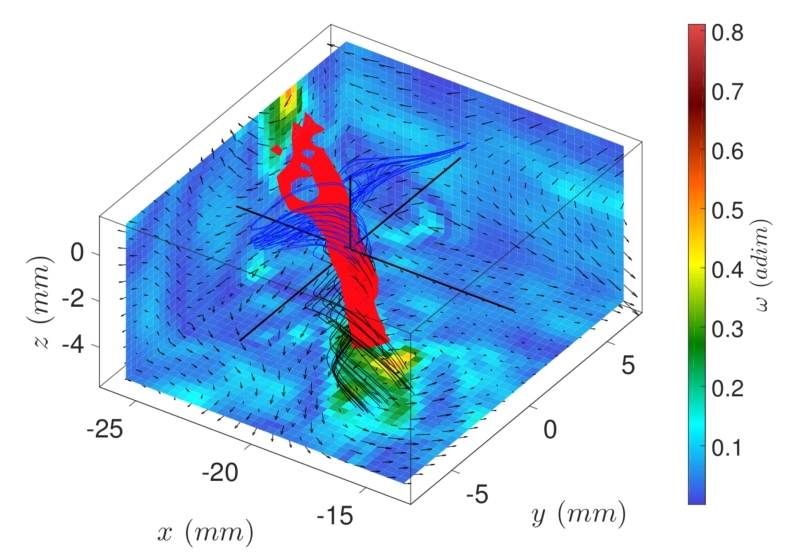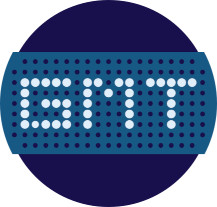ANR TILT
This project is devoted to studying and modeling the fine structure of fluid turbulence, which affects a wide range of phenomena in science and engineering.
- A surprising and still poorly understood property of the infinite-Reynolds-number limit for turbulent flow is the existence of a finite viscous dissipation, even when viscosity becomes vanishingly small. To maintain such an efficient way of dissipating energy, the flow self-organizes, following a cascading process, and develops a tortuous spatial structure at small scales. Asymptotically, various kinematic quantities, such as the velocity, become rough and non-differentiable. The finiteness of the rate at which injected energy is turned into heat in the fully developed turbulent regime is known as the dissipative anomaly. This property rests on the singular nature and deep irreversibility of turbulent flows, and is the source of severe difficulties when applying concepts developed in equilibrium statistical mechanics.
- The present project aims at obtaining quantitative progress in the understanding of this highly singular behavior. For this, we propose to build a consortium of leading theoretical and computational physicists from this field of research, and to put the focus on the irreversible nature of turbulence. There will be special emphasis regarding the signature of irreversible processes on the motion of tracers transported by the flow.
- The collaborative network will be articulated around the generation of a database containing results of state-of-the-art simulations of (i) the Navier-Stokes equation, of (ii) a newly proposed systems, describing a fluid velocity field, with a \textit{reversible} dissipation, of (iii) weak dissipative solutions of the Euler equations, following a recently proposed method of construction, and last, (iv) synthetic random fields allowing us to study the signature of various key statistical ingredients of turbulence phenomenology. This database will be made accessible to all the participants for answering questions raised in several workpackages developed in the course of the project.
- The consortium consists of 3 groups with complementary numerical and theoretical expertise, in statistical mechanics and fluid turbulence. They are located in Saclay, at CEA (B. Dubrulle), in Lyon, at ENSL (L. Chevillard, A. Pumir), and in Nice, both at MINES ParisTech and at the Observatoire de la Cote d’Azur (J. Bec, N. Besse, U. Frisch). The potential knowledge gained will be key in developing a better description and improved models of turbulent fluctuations in processes such as transport or mixing.
Publications from TILT
- A. Cheminet, D. Geneste, A. Barlet, Y.Ostovan, T. Chaabo, V. Valori, P. Debue, C.Cuvier, F. Daviaud, J.-M. Foucaut, J.-P. Laval, V. Padilla, C. Wiertel, B. Dubrulle, Eulerian vs Lagrangian Irreversibility in an experimental turbulent swirling flow, accepted to Physical Review Letter as editor suggestion (2022)
Latest News from TILT
- May 2022: First results on Eulerian vs Lagrangian irreversibility… and Editor suggestion of PRL!
- September 2021: Guillaume Costa joins the team for a 3 years PhD in SPEC with B. Dubrulle. Welcome!
- January 2021: Start of the project!
ANR EXPLOIT
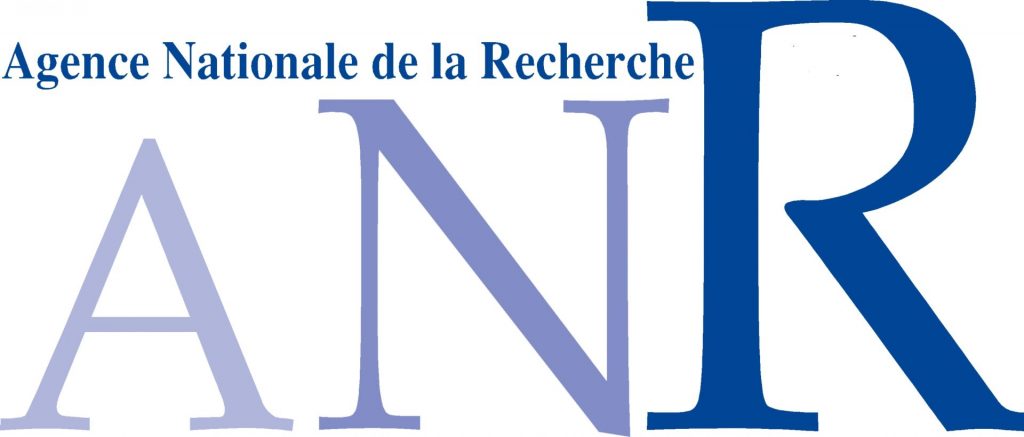

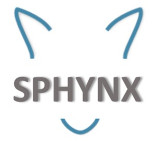
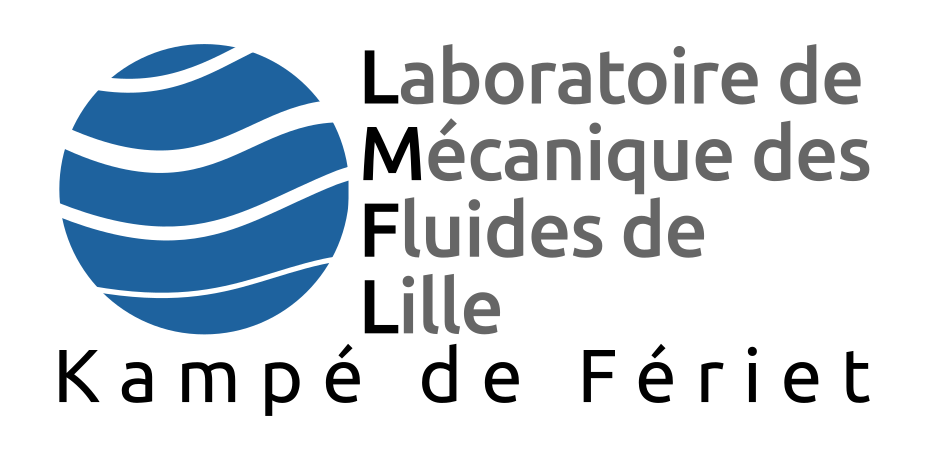

Experimental study of dissipation structures in turbulence
Viscous flows are ubiquitous in nature and impact many areas of physics, engineering sciences, astrophysics, geophysics or aeronautics. The minimal knowledge every scientist has about them is that if you stir strongly enough a viscous flow, it becomes turbulent and displays a power-law energy spectrum characteristic of scale to scale energy transfer, by which all the energy injected at large scales is transferred and dissipated at small scales. However, it was only understood in 1961 by Landau and Kolmogorov that the characterization of the properties of this dissipation is crucial, not only to understand fundamental issues such as intermittency corrections to the Kolmogorov spectrum, but also to tackle practical issues such as drag reduction or numerical modelisation of turbulent flows.
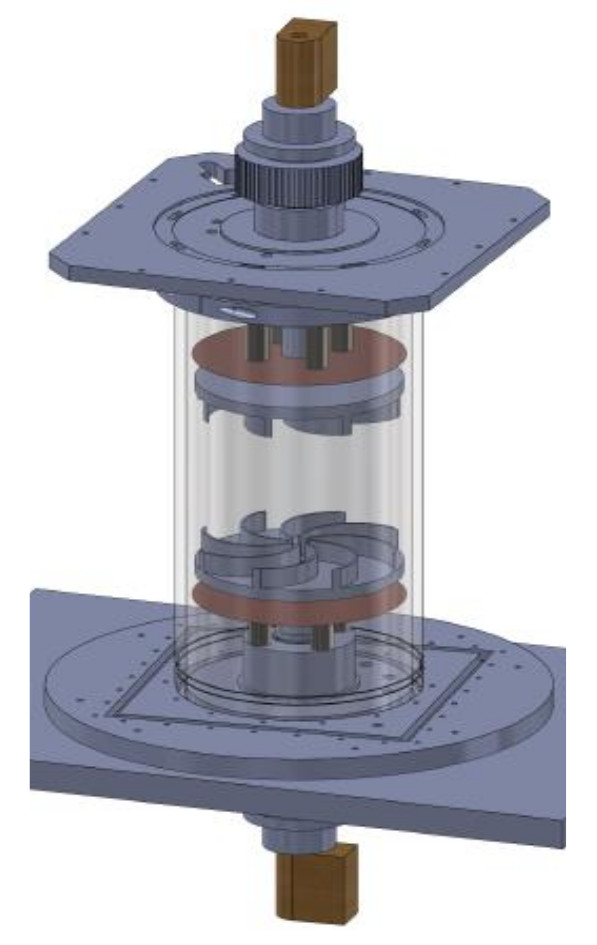
The drag phenomenon is due to the dissipation induced by a moving object (like a car or a boat) in a fluid and is far more important in the turbulent regime than in the laminar one. With the end of an era of cheap, unlimited energy, it becomes of crucial importance to build efficient cars, ships, airplanes…, and try to lower their energy consumption. The present technological progresses on the drag have given interesting results but with neither real understanding of the origin of this phenomenon nor of its scaling laws. Recent advances in mathematical analysis of the equations governing viscous flow seem to indicate that there is a link between the scaling of dissipation in a turbulent fluid and the development of singularities. However very little is known about the dynamics and statistics of the corresponding dissipative structures, leaving a gap between the drag phenomenon and its theoretical explanation.
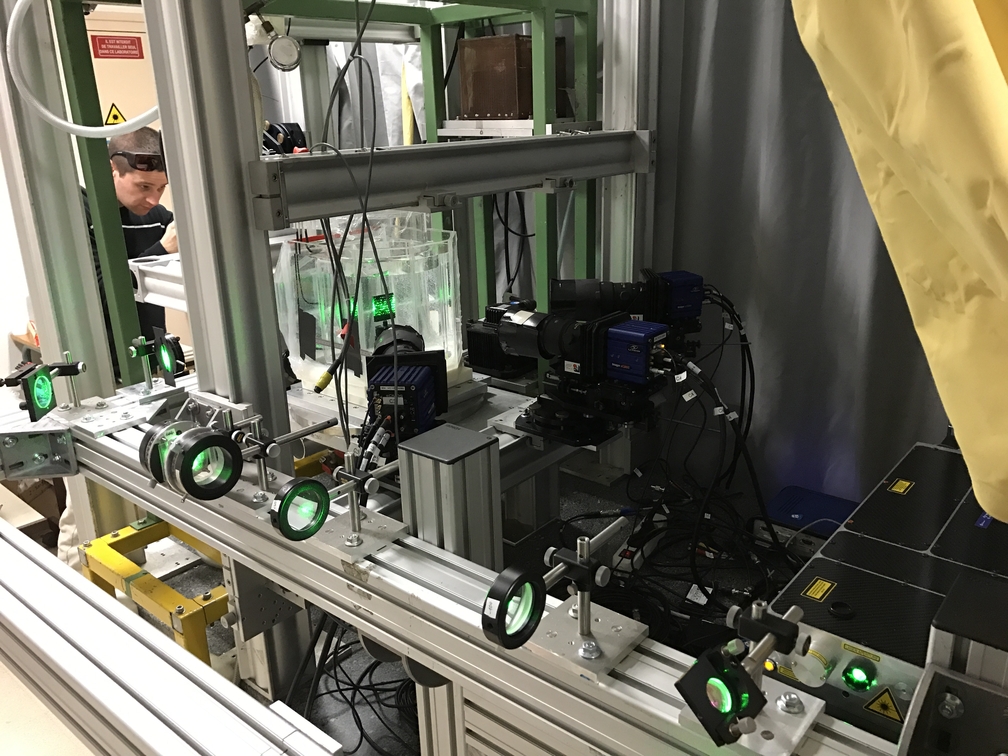
The EXPLOIT project aims at filling this gap by providing a characterization of dissipation structures based on an experimental analysis of a model turbulent flow using multi-scale tools and advanced visualization techniques in a dedicated meter-size turbulent experiment.The aim of the EXPLOIT project is:
- Build a novel meter-size dedicated experiments instrumented with a high resolution space and time resolved 3D-PIV system;
- Detect the dissipation structures experimentally by following them in the scale space down to the dissipative scale to capture their dynamics and statistical properties
- Explore their universality by systematic variation of the control parameters (Reynolds number) and of the forcing conditions.
Publications from EXPLOIT
- Debue, P., , D. Kuzzay, E.-W. Saw, F. Daviaud, B. Dubrulle, L. Canet, V. Rosseto, N. Wschebor, Experimental test of the crossover between the inertial and the dissipative range in a turbulent swirling flow, Phys. Rev. Fluids, 024602, (2018).
- Debue, P., Shukla, V., D. Kuzzay, D. Faranda, E.-W. Saw, F. Daviaud, B. Dubrulle, Dissipation, intermittency, and singularities in incompressible turbulent flows, Phys. Rev. E, 053101, (2018).
- B. Dubrulle, Beyond Kolmogorov, J. Fluid Mech. perspectives, 867, 1-52 (2019).
- Geneste, D. Faller, H. Debue, P., Nguyen, F. Shukla, V., Laval, J-P. Daviaud, F. , E.-W. Saw, Dubrulle,B. Universality and Thermodynamics of Turbulence, Entropy, 21(3), 326 (2019).
- V. Shukla, B. Dubrulle, S. Nazarenko, G. Krstulovic, S. Thalabard, Phase transition in time-reversible Navier-Stokes equations, Phys. Rev. E 100, 043104 (2019).
- F. Nguyen, J-P. Laval, P. Kestener A. Cheskidov, R. Shvydkoy and B. Dubrulle, Local estimates of Hlder exponents in turbulent vector fields, Phys. Rev. E 99, 053114 (2019).
- Zecong Qin, Hugues Faller, Brengre Dubrulle, Aurore Naso, and Wouter J. T. Bos. Transition from non-swirling to swirling axisymmetric turbulence , Phys. Rev. Fluids 5, 064602 (2020)
- Valentina Valori, Alessio Innocenti, Brengre Dubrulle and Sergio Chibbaro, Weak formulation and scaling properties of energy fluxes in three-dimensional numerical turbulent Rayleigh-Bnard convection, J. Fluid mechanics, 885, A14 (2020).
- L. Cappanera, P. Debue, H. Faller, D. Kuzzay, E-W. Saw, C. Nore, J.-L. Guermond, F. Daviaud, C. Wiertel-Gasquet, B. Dubrulle Turbulence in realistic geometries with moving boundaries: When simulations meet experiments Computers and Fluids 214 (2021) 104750
- A. Cheminet, Y. Ostovan, V. Valori, C. Cuvier, F. Daviaud, P. Debue, B. Dubrulle, J- M. Foucaut, J-P. Laval, Optimization of regularized B-spline smoothing for turbulent Lagrangian trajectories , Experimental Thermal and Fluid Science (2021), doi: https://doi.org/10.1016/j.expthermflusci.2021.110376
- P. Debue, V. Valori, C. Cuvier, F. Daviaud, J.-M. Foucaut, J.-P. Laval, C. Wiertel, V. Padilla and B. Dubrulle. Three-dimensional analysis of precursors to non-viscous dissipation in an experimental turbulent flow , J. Fluid Mech. 914, A9, (2021)
- H. Faller et al, On the nature of intermittency in a turbulent von Kármán flow Journal of Fluid Mechanics, 914, A2. doi:10.1017/jfm.2020.908
- Dubrulle, B. and Gibbon, A correspondence between the multifractal model of turbulence and the Navier-Stokes equations J., Phil. Trans. R. Soc. A.3802021009220210092 (2022).
- Dubrulle, B. and Daviaud, F. and Faranda, D. and Marié, L. and Saint-Michel, B., How many modes are needed to predict climate bifurcations? Lessons from an experiment Nonlinear Processes in Geophysics,29, 17—35 (2022)
- A. Cheminet, D. Geneste, A. Barlet, Y.Ostovan, T. Chaabo, V. Valori, P. Debue, C.Cuvier, F. Daviaud, J.-M. Foucaut, J.-P. Laval, V. Padilla, C. Wiertel, B. Dubrulle, Eulerian vs Lagrangian Irreversibility in an experimental turbulent swirling flow, accepted to Physical Review Letter as editor suggestion (2022)
Papers in Proceedings from EXPLOIT
- F. Nguyen , B. Dubrulle , J.-P. Laval, P. Kestener, Multifractal analysis of turbulent flow, 16th European Turbulence Conference, 21-24 August, 2016, Stockholm, Sweden.
- A. Cheminet, V. Valori, T. Chaabo, Y. Ostovan, P. Debue, C. Cuvier, B. Dubrulle, J.-P. Laval, J.-M. Foucaut, C. Wiertel, V. Padilla, F. Daviaud, Impact of lagragian trajectory filtering on turbulent statistics in 4D-PTV meseaurement on von Karman flow, 17th European Turbulence Conference (ETC17), 2-3 September, Torino, Italy.
- P. Debue, V. Valori, C. Cuvier, J.-M. Foucaut, F. Daviaud, J.-P. Laval, B. Dubrulle, Topology of quasi-singularities in an experimental turbulent swirling flow, 17th European Turbulence Conference (ETC17), 2-3 September, Torino, Italy.
- B. Dubrulle, V. Valori, T. Chaabo, A. Cheminet, Y. Ostovan, C. Cuvier, J.-P. Laval, J.-M. Foucaut, C. Wiertel, V. Padilla, F. Daviaud, Eulerian vs Lagrangian irreversibility in an experimental turbulent von Karman flow, 17th European Turbulence Conference (ETC17), 2-3 September, Torino, Italy.
- F. Nguyen, J.-P. Laval, B. Dubrulle, Local estimate of Holder exponents in a turbulent vector fields, 17th European Turbulence Conference (ETC17), 2-3 September, Torino, Italy.
- Y. Ostovan, C. Cuvier, P. Debue, V. Valori, A. Cheminet, T. Chaabo, J.-M. Foucaut, J.-P. Laval, C. Wiertel, V. Padilla, B. Dubrulle, F. Daviaud, 4-D tracking velocimetry measurements in a von Karman turbulence experiment, 17th European Turbulence Conference (ETC17), 2-3 September, Torino, Italy.
- Y. Ostovan, C. Cuvier, P. Debue, V. Valori, A. Cheminet, T. Chaabo, J.-M. Foucaut, J.-P. Laval, C. Wiertel, V. Padilla, B. Dubrulle, F. Daviaud, 4-D tracking velocimetry measurements in a von Karman turbulence experiment, 13th International Symposium on Particles Image Velocimetry – ISPIV 2019, Munich, Germany, July 22-24.
Related Publications of the EXPLOIT team members
- D. Kuzzay, E.-W. Saw, F.J.W.A. Martins, D. Faranda, J.-M. Foucaut, F. Daviaud, B. Dubrulle, New method for detecting singularities in experimental incompressible flows, Nonlinearity 30(6), 2381.
- E.-W. Saw, D. Kuzzay, D. Faranda, A. Guittonneau, F. Daviaud, C. Wiertel-Gasquet, V. Padilla, B. Dubrulle, 2017, Experimental characterization of extreme events of inertial dissipation in a turbulent swirling flow, Nature communications 7, 12466.
Latest News from EXPLOIT
- June 2022: This is the end of the project…. But the team EXPLOIT is continuing its exploration of sub-Kolmogorov scales, so stay tuned!
- May 2022: First results from GVK… and Editor suggestion of PRL! Congratuation to all the team.
- June 2021: At last! We had our first campaign of experiment on GVK, reaching sub-Kolmogorov scales… We now have to treat the data…
- December 2020: Adam Cheminet is joining the team as a permanent member, serving as CEA junior researcher at SPEC in charge of GVK. Congrat!
- March 2020: Due to COVID, the arrival of our GVK in Saclay is postponed to September… Let us be patient!
- February 2020: Valentina Valori left the team for a 3 years post-doc in Illmenau. Good luck!
- January 2020: Adam Cheminet joins the team for a 1 years post-doc in Saclay. Welcome!
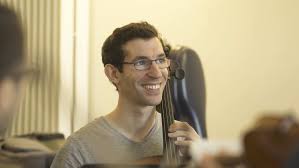
- October 2019: E pur si muove! Our Giant von Karman is now ready for tests at the local of GP Concept! We hope to welcome it in Saclay soon, when the new building is ready.
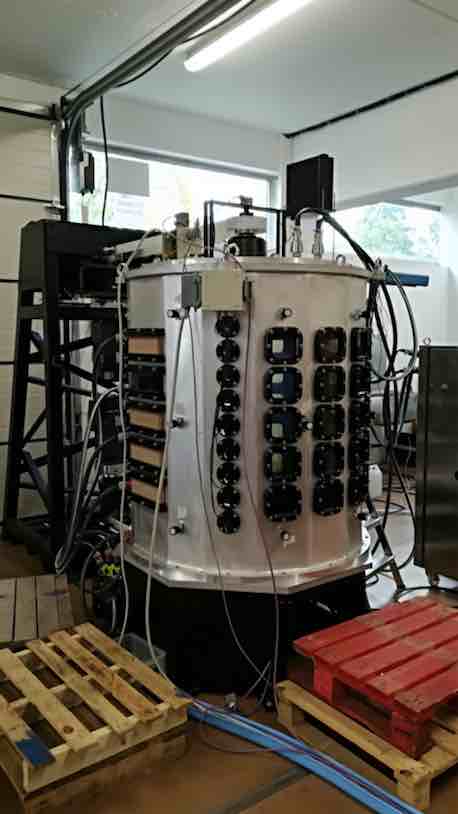
- September 2019: Paul Debue, PhD student of F. Daviaud and B. Dubrulle, successfully defended hi PhD thesis entitled An Experimental approach to the problem of the Navier-Stokes singularities. He has become a doctor of the University Paris-Saclay and left the team to become a researcher at Air Liquide. Congratulations!
- September 2019: Damien Geneste joins the team for a 3 years PhD in Saclay and Lille with F. Daviaud, J-P. Laval and B. Dubrulle. Welcome!

- September 2018: Tarek Chaabo joins the team for a 3 years PhD in Lille with J-P. Laval and J-M. Foucaut. Welcome!
- June 2018: We performed our first official TPIV experiment on the small von Karman
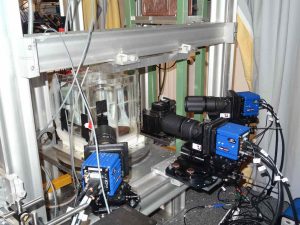
- February 2018: Valentina Valori joins the team for a 2 years post-doc in Saclay. Welcome!

- March 2017: Ewe-Wei Saw left the EXPLOIT team to take a permanent position at Sun Yat-Sen University, Zhuhai, China. Good luck on your new job Ewe-Wei!

- January 2017: the EXPLOIT team is performing tests on the small von Karman apparatus with the help two LaVision people
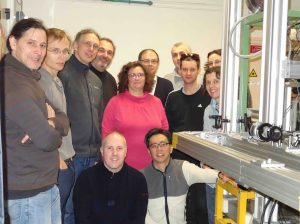
Gallerie
Picture of Our Giant von Karman
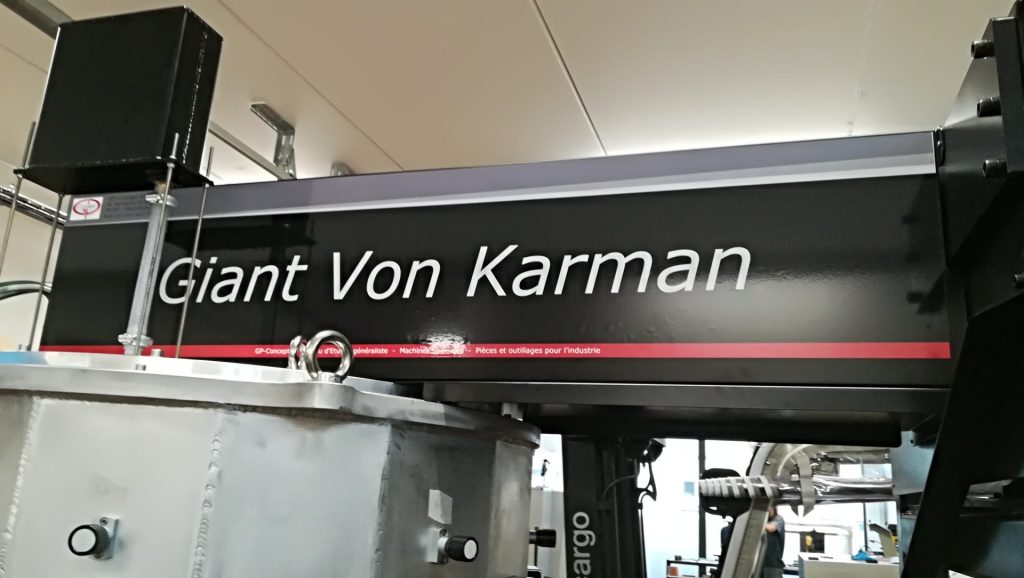
Trajectories of particles from a PTV experiment on the small von Karman
The corresponding Duchon-Rober indicator
A quasi-singularity found during the thesis of Paul Debue
